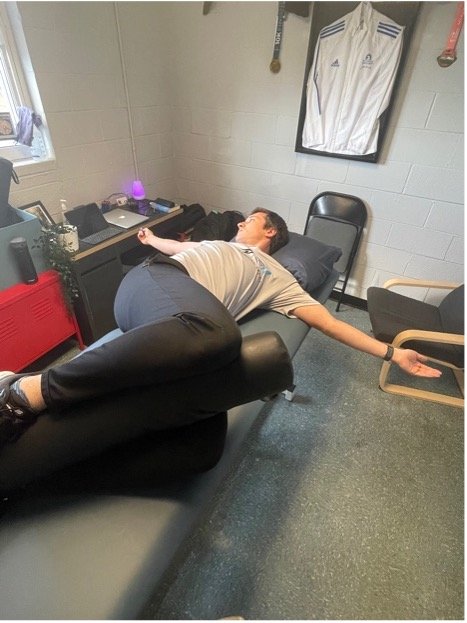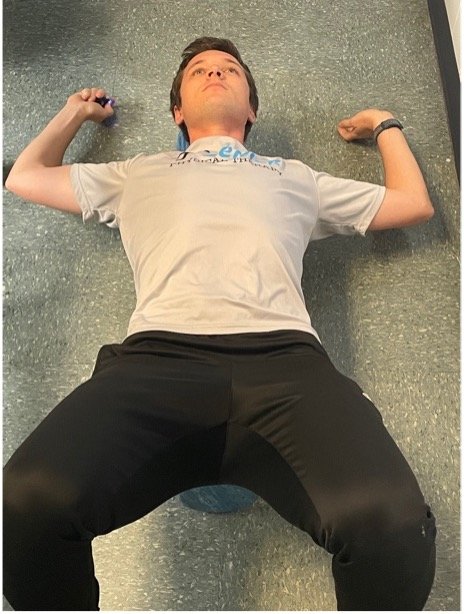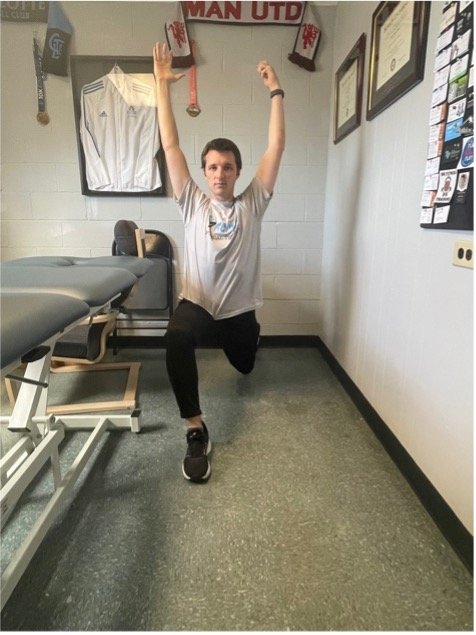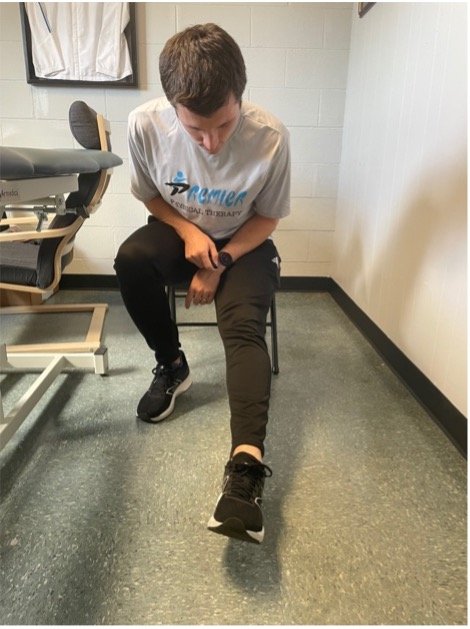Premier Physical Therapy Mini Mobility Guide
Most of us spend too much time sitting.
There has been a huge increase in sedentary behavior that stems from the recent ubiquity of smartphones, tablets, and computers. We know that prolonged sedentary behavior is not healthy for both the individual and the broader population.
Long-term sitting puts us in positions of excessive hip flexor and hamstring shortness, which tug on the low back day and night. That is compounded with our propensity to sit with poor posture; the shoulders round, the normal lordotic curvature at the low back disappears, the neck protrudes forward. This leads to an increased risk of developing neck and low back pain, rotator cuff tears, nerve pain down the leg, and hip impingement, among others. Left unaddressed, these small annoyances can turn into long-term, chronic pain.
So let’s spend 10 minutes per day reducing your risk of heading down this path!
Welcome to the Premier Physical Therapy Mini Mobility Guide.
This guide walks you through four daily exercises to counteract the impacts of prolonged sitting. But doing the exercises is only half the battle. As you read on, take a moment to be cognizant of each carefully chosen word. Think about how these words apply to your unique circumstances. A key tenet of psychology is: “if your mental state isn’t appropriate prior to exercise, you’re unlikely to succeed.” This applies to everyone from those of us just getting off the couch to professional athletes.
Think about a recent “bad day” you had at work. What specifically about the day was bad? Was the entire day negative? Chances are, one or two negative things happened that undid all the good from the day. And when you go home at night, you are inclined to fixate on the one negative above all else. Sound familiar?
Retraining the brain to focus on the positive is not easy. After all, we are hardwired to be negative. It takes regular reminders and daily practice to shift towards the positivity. When you find yourself heading down a negative pathway, recognize the need to stop the thought and then shift towards a positive rephrasing. Something like “I can’t do that” becomes “I’m not sure I can do it but I’ll give it my best shot.” When done consistently, this will teach the brain to be more positive, leading to more success!
Focus on the positivity and on your deep breathing while you proceed through the following mobility exercises:
1A. Thoracic spine foam roller, perpendicular: Grab a ~3-foot long foam roller of medium density. Orient the foam roller perpendicular to your mid-back (thoracic spine), then place your mid-back on the foam roller. Give yourself a hug with both arms and bend your knees, with your feet firmly planted on the ground. Lift your bottom off the floor so the foam roller is pressed against your back. (If you’re dealing with neck pain or headaches, feel free to support your head with your hands instead of the hug.) Roll back and forth, stay on a sore spot, or bend backwards over the foam roller- whatever feels right! Keep your abdomen contracted lightly while continuing to breathe deeply, being cognizant of areas of tension and popping/cracking/cavitations that occur. Perform for 1-2 minutes.
1B: If a foam roller is not available, complete the open book stretch instead. For the open book, lie on your left side with a pillow under your head and another between your knees. Tuck your knees close to your chest. Reach your arms out to the side so your palms are touching. Watch your right hand (top hand) with your eyes and follow it as you raise the right arm away from the left as far as you can. Keep your knees together and against the table as you do this. At the end of the motion, take a deep breath, being cognizant of the stretch in the front of the chest and throughout the spine. Return to the starting position and repeat 10 repetitions per side. If you have a history of shoulder pain or dislocation, reduce the distance your arm travels.
2A. Thoracic spine foam roller, parallel: Using that same foam roller, orient it parallel to your mid-back, then place your back length-wise on the foam roller: one end on your bottom, the other end supporting your head. Bend your knees and plant your feet on the ground for balance. Lightly contract your abdomen to prevent yourself from falling off the foam roller. Raise your arms so your shoulders and elbows are in a 90-degree angle, allowing your elbows to lower towards the floor. You should feel a stretch in the front of the chest. This will help stretch the pectoralis major and minor, relieving the rounded shoulders from abnormal sitting posture. If you have a history of shoulder pain or dislocations, be careful with your arm positioning. Perform for 1-2 minutes.
2B: If a foam roller is not available, complete the doorway pec stretch instead. Stand in an open doorway with your left foot forward. Place your right forearm on the doorframe, running vertically. The length of your forearm should be on the doorframe, and your shoulder and elbow should both be bent to about 90 degrees. Shift your body weight forward and turn your shoulders to the left. You should feel a stretch in the front of the right chest. Hold for about 30 seconds, repeating 4-5 repetitions per side. If you have a history of shoulder pain or dislocation, reduce the forward shift and/or lower your arm slightly.
3. Walking lunges with arm raise: Find a hallway or a space with a fair amount of distance to walk. Take a big step forward with the left leg and lunge, allowing the knees to bend to about 90 degrees. Keep the hip, knee, and ankle orientation vertical; don’t allow the knee to drift inwards. In this position, you should feel a stretch in the front of the right hip and thigh. Hold this position and squeeze your abdomen lightly. Keeping the right knee slightly off the ground, raise both arms overhead. Hold for about 5 seconds, focusing on your deep breathing, then step forward and alternate sides. Repeat 8 repetitions on each side.
4. Seated hamstring stretch without arm reach: this seems like a simple stretch but form is of the utmost importance. Sitting on the edge of a chair or other elevated surface, straighten the left leg and relax your ankle (don’t pull your toes up!). With your hands on your waist, bend at the hips until you feel a stretch behind your left thigh. Don’t reach for your toes. (This encourages lumbar flexion, not hip flexion, which is much more likely to solicit a sciatic nerve stretch, not a hamstring stretch.) Hold for 30 seconds, repeating 4-5 sets per leg. If your leg experiences numbness or tingling before 30 seconds, stop the stretch and resume only after the sensation has fully subsided. The goal is to stretch between 100-150 seconds total per side, as this yields consistent tissue length change that is not seen in occasional stretching or ballistic stretching. This may mean that you perform 5 sets of 30 seconds, 10 sets of 15 seconds, or a different timing of your choice.
-----------
When done consistently at the start of the day, especially if you’ve prefaced the movements with positive thinking, you should find yourself happier and more refreshed. Why? Exercise and stretching improves the efficiency of dopamine release and neurotransmitter regulation. These are related to the “high” that folks sometimes get during or after running or generalized exercise.
This mobility guide serves as advice for the general population. We are, of course, individuals and we all differ from each other. You may need to adjust a direction or two to best suit your personal needs, particularly if you are managing an injury or post-surgical condition. Please see your physical therapist before beginning any new exercise routine to ensure all safety precautions are being followed. And if you need additional help, we at Premier Physical Therapy are in an excellent position to help you!
Life is short. This type of pain is preventable. Let’s prevent chronic pain by addressing it today, both physically and mentally.







